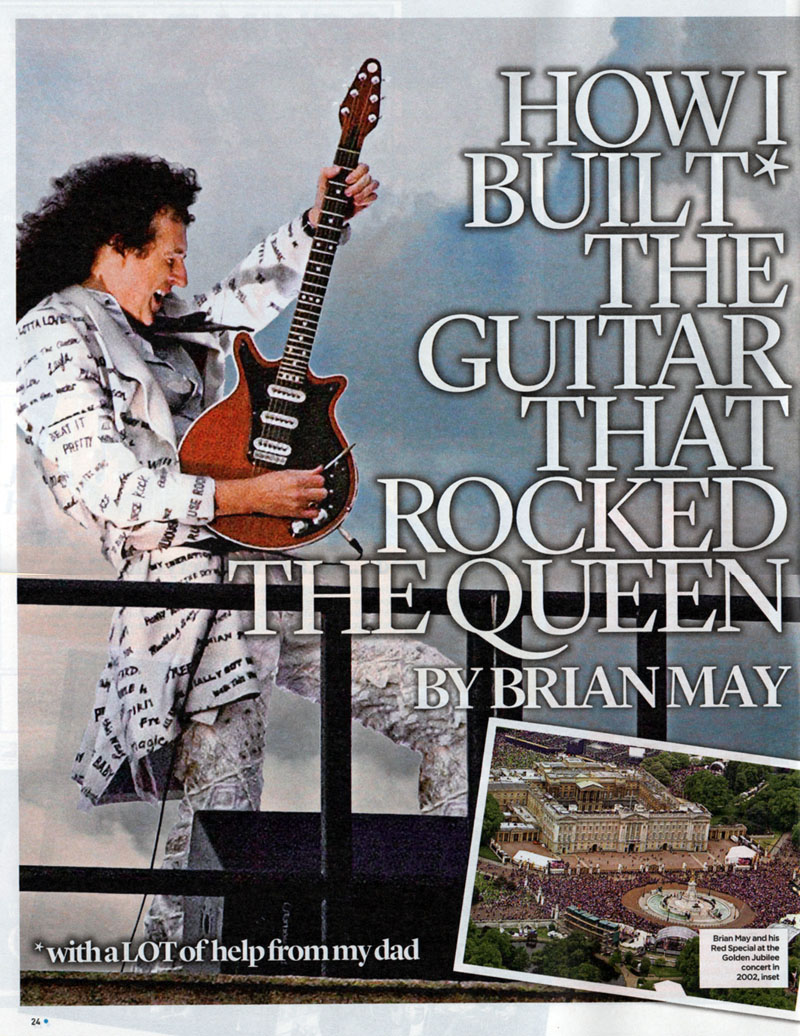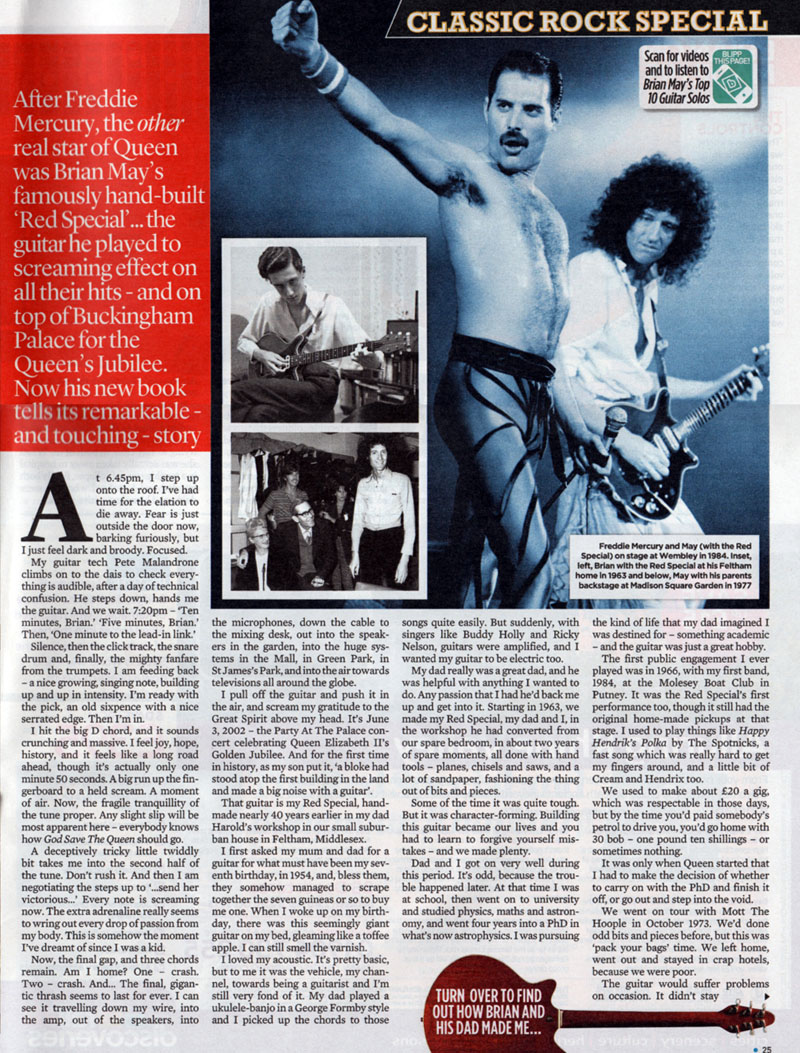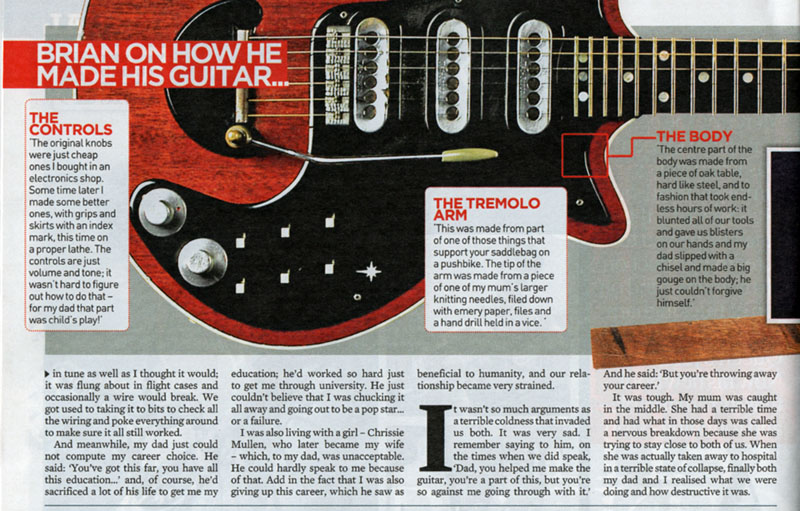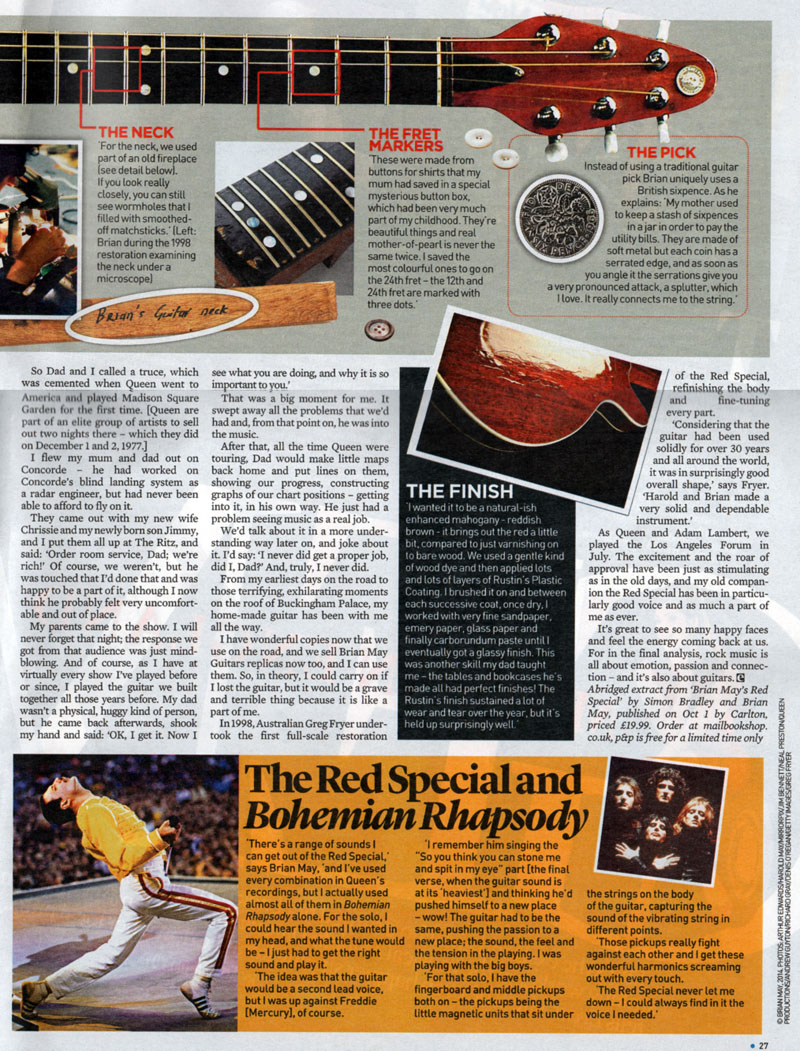The official launch of the book takes place Wed 01 October.
An extract from the new book “Brian May’s Red Special” is printed in The Mail On Sunday ‘Event’ magazine today (UK only. as a taster of what can be expected when the book launches on 1st October. There is also a panel focussing on the Red Special’s role in ‘Bohemian Rhapsody’.
27 September 2014 by Brian May
After Freddie Mercury, the other real star of Queen was Brian May’s famously hand-built ‘Red Special’… the guitar he played to screaming effect on all their hits – and on top of Buckingham Palace for the Queen’s Jubilee. Now his new book tells its remarkable – and touching – story
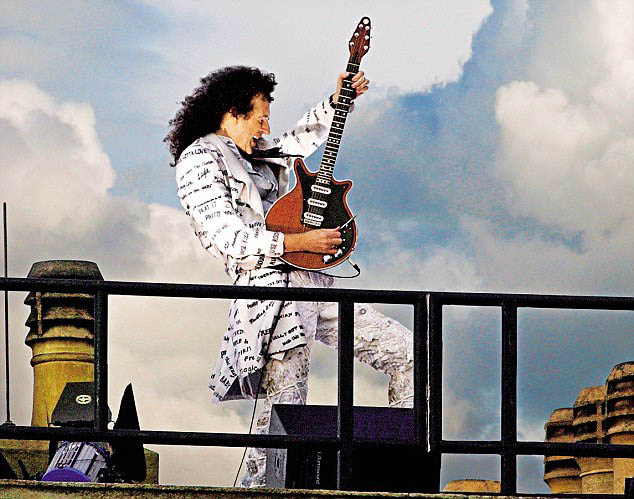
Brian May and his Red Special guitar at the Golden Jubilee concert in 2002. It was hand-made nearly 40 years earlier in his dad’s workshop in their small suburban house in Feltham, Middlesex
It was hand-made nearly 40 years earlier in his dad’s workshop in their small suburban house in Feltham, Middlesex. At 6.45pm, I step up onto the roof. I’ve had time for the elation to die away. Fear is just outside the door now, barking furiously, but I just feel dark and broody. Focused.
My guitar tech Pete Malandrone climbs on to the dais to check everything is audible, after a day of technical confusion. He steps down, hands me the guitar. And we wait. 7:20pm – ‘Ten minutes, Brian. Five minutes, Brian.’ Then, ‘One minute to the lead-in link.’
Silence, then the click track, the snare drum and, finally, the mighty fanfare from the trumpets. I am feeding back – a nice growing, singing note, building up and up in intensity. I’m ready with the pick, an old sixpence with a nice serrated edge. Then I’m in. I hit the big D chord, and it sounds crunching and massive. I feel joy, hope, history, and it feels like a long road ahead, though it’s actually only one minute 50 seconds. A big run up the fingerboard to a held scream. A moment of air.
Now, the fragile tranquility of the tune proper. Any slight slip will be most apparent here – everybody knows how God Save The Queen should go. A deceptively tricky little twiddly bit takes me into the second half of the tune. Don’t rush it. And then I am negotiating the steps up to ‘…send her victorious…’
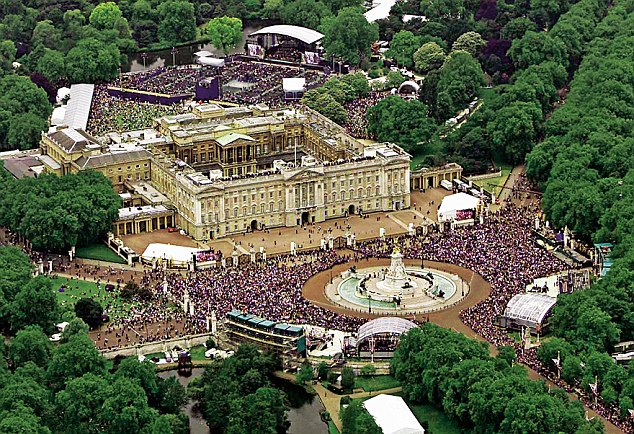
‘From my earliest days on the road to those terrifying, exhilarating moments on the roof of Buckingham Palace, my home-made guitar has been with me all the way,’ said Brian
Every note is screaming now. The extra adrenaline really seems to wring out every drop of passion from my body. This is somehow the moment I’ve dreamt of since I was a kid.
Now, the final gap, and three chords remain. Am I home? One – crash. Two – crash. And… The final, gigantic thrash seems to last for ever. I can see it travelling down my wire, into the amp, out of the speakers, into the microphones, down the cable to the mixing desk, out into the speakers in the garden, into the huge systems in the Mall, in Green Park, in St James’s Park, and into the air towards televisions all around the globe. I pull off the guitar and push it in the air, and scream my gratitude to the Great Spirit above my head.
It’s June 3, 2002 – the Party At The Palace concert celebrating Queen Elizabeth II’s Golden Jubilee. And for the first time in history, as my son put it, ‘a bloke had stood atop the first building in the land and made a big noise with a guitar’. That guitar is my Red Special, hand-made nearly 40 years earlier in my dad Harold’s workshop in our small suburban house in Feltham, Middlesex.
I first asked my mum and dad for a guitar for what must have been my seventh birthday, in 1954, and, bless them, they somehow managed to scrape together the seven guineas or so to buy me one. When I woke up on my birthday, there was this seemingly giant guitar on my bed, gleaming like a toffee apple. I can still smell the varnish. I loved my acoustic. It’s pretty basic, but to me it was the vehicle, my channel, towards being a guitarist and I’m still very fond of it.
My dad played a ukulele-banjo in a George Formby style and I picked up the chords to those songs quite easily. But suddenly, with singers like Buddy Holly and Ricky Nelson, guitars were amplified, and I wanted my guitar to be electric too.
My dad really was a great dad, and he was helpful with anything I wanted to do. Any passion that I had he’d back me up and get into it.
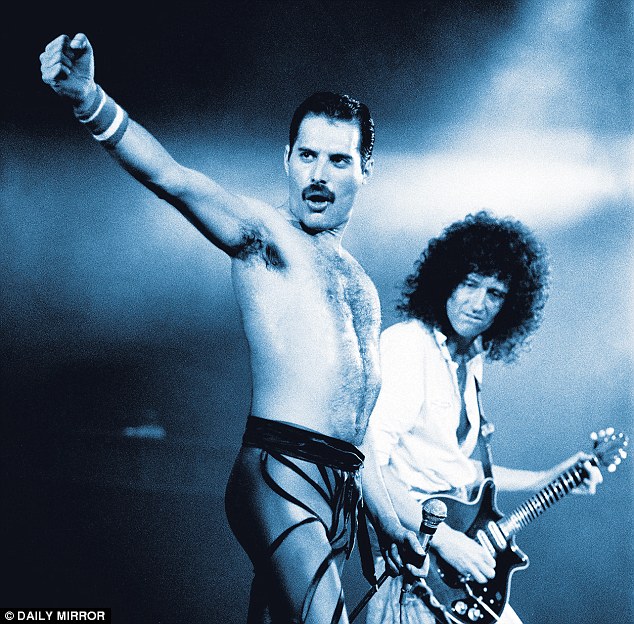
Brian (with the Red Special) and Freddie Mercury on stage at Wembley in 1984
Starting in 1963, we made my Red Special, my dad and I, in the workshop he had converted from our spare bedroom, in about two years of spare moments, all done with hand tools – planes, chisels and saws, and a lot of sandpaper, fashioning the thing out of bits and pieces. Some of the time it was quite tough. But it was character-forming. Building this guitar became our lives and you had to learn to forgive yourself mistakes – and we made plenty. Dad and I got on very well during this period. It’s odd, because the trouble happened later.
At that time I was at school, then went on to university and studied physics, maths and astronomy, and went four years into a PhD in what’s now astrophysics. I was pursuing the kind of life that my dad imagined I was destined for – something academic – and the guitar was just a great hobby.
The first public engagement I ever played was in 1966, with my first band, 1984, at the Molesey Boat Club in Putney. It was the Red Special’s first performance too, though it still had the original home-made pickups at that stage. I used to play things like Happy Hendrik’s Polka by The Spotnicks, a fast song which was really hard to get my fingers around, and a little bit of Cream and Hendrix too. We used to make about £20 a gig, which was respectable in those days, but by the time you’d paid somebody’s petrol to drive you, you’d go home with 30 bob – one pound ten shillings – or sometimes nothing.
It was only when Queen started that I had to make the decision of whether to carry on with the PhD and finish it off, or go out and step into the void. We went on tour with Mott The Hoople in October 1973. We’d done odd bits and pieces before, but this was ‘pack your bags’ time. We left home, went out and stayed in crap hotels, because we were poor.
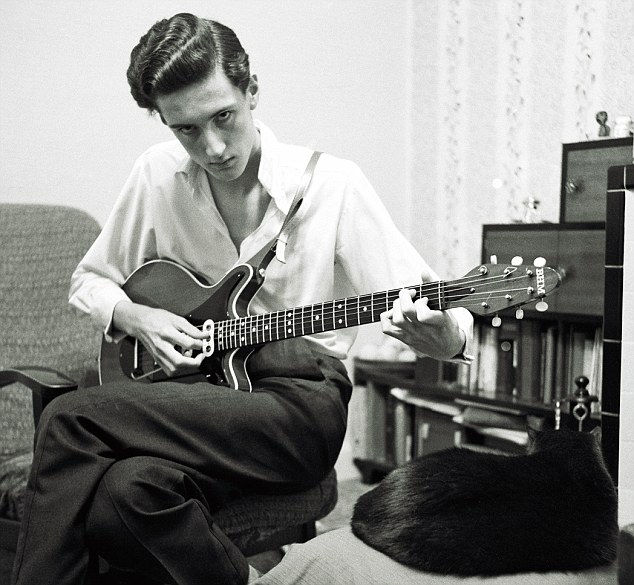
Brian with the Red Special at his Feltham home in 1963. The guitar was made ‘in about two years of spare moments, all done with hand tools – planes, chisels and saws, and a lot of sandpaper’
The guitar would suffer problems on occasion. It didn’t stay in tune as well as I thought it would; it was flung about in flight cases and occasionally a wire would break. We got used to taking it to bits to check all the wiring and poke everything around to make sure it all still worked.
And meanwhile, my dad just could not compute my career choice. He said: ‘You’ve got this far, you have all this education…’ and, of course, he’d sacrificed a lot of his life to get me my education; he’d worked so hard just to get me through university. He just couldn’t believe that I was chucking it all away and going out to be a pop star… or a failure.
I was also living with a girl – Chrissie Mullen, who later became my wife – which, to my dad, was unacceptable. He could hardly speak to me because of that. Add in the fact that I was also giving up this career, which he saw as beneficial to humanity, and our relationship became very strained. It wasn’t so much arguments as a terrible coldness that invaded us both. It was very sad.
I remember saying to him, on the times when we did speak, ‘Dad, you helped me make the guitar, you’re a part of this, but you’re so against me going through with it.’ And he said: ‘But you’re throwing away your career.’
It was tough. My mum was caught in the middle. She had a terrible time and had what in those days was called a nervous breakdown because she was trying to stay close to both of us. When she was actually taken away to hospital in a terrible state of collapse, finally both my dad and I realised what we were doing and how destructive it was. So Dad and I called a truce, which was cemented when Queen went to America and played Madison Square Garden for the first time. [Queen are part of an elite group of artists to sell out two nights there – which they did on December 1 and 2, 1977.]
I flew my mum and dad out on Concorde – he had worked on Concorde’s blind landing system as a radar engineer, but had never been able to afford to fly on it. They came out with my new wife Chrissie and my newly born son Jimmy, and I put them all up at The Ritz, and said: ‘Order room service, Dad; we’re rich!’. Of course, we weren’t, but he was touched that I’d done that and was happy to be a part of it, although I now think he probably felt very uncomfortable and out of place.
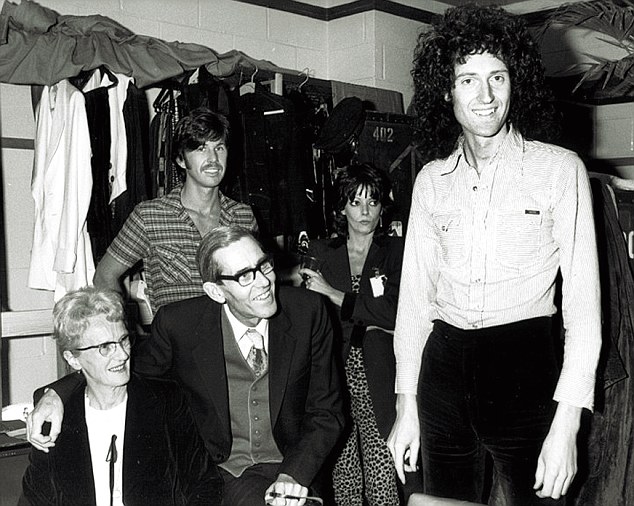
Brian with his parents backstage at Madison Square Garden in 1977. Queen are part of an elite group of artists to sell out two nights there
My parents came to the show. I will never forget that night; the response we got from that audience was just mind-blowing. And of course, as I have at virtually every show I’ve played before or since, I played the guitar we built together all those years before.
My dad wasn’t a physical, huggy kind of person, but he came back afterwards, shook my hand and said: ‘OK, I get it. Now I see what you are doing, and why it is so important to you.’ That was a big moment for me. It swept away all the problems that we’d had and, from that point on, he was into the music.
After that, all the time Queen were touring, Dad would make little maps back home and put lines on them, showing our progress, constructing graphs of our chart positions – getting into it, in his own way. He just had a problem seeing music as a real job. We’d talk about it in a more understanding way later on, and joke about it. I’d say: ‘I never did get a proper job, did I, Dad?’ And, truly, I never did.
From my earliest days on the road to those terrifying, exhilarating moments on the roof of Buckingham Palace, my home-made guitar has been with me all the way. I have wonderful copies now that we use on the road, and we sell Brian May Guitars replicas now too, and I can use them. So, in theory, I could carry on if I lost the guitar, but it would be a grave and terrible thing because it is like a part of me.
In 1998, Australian Greg Fryer undertook the first full-scale restoration of the Red Special, refinishing the body and fine-tuning every part.
‘Considering that the guitar had been used solidly for over 30 years and all around the world, it was in surprisingly good overall shape,’ says Fryer. ‘Harold and Brian made a very solid and dependable instrument.’
As Queen and Adam Lambert, we played the Los Angeles Forum in July. The excitement and the roar of approval have been just as stimulating as in the old days, and my old companion the Red Special has been in particularly good voice and as much a part of me as ever. It’s great to see so many happy faces and feel the energy coming back at us.
For in the final analysis, rock music is all about emotion, passion and connection – and it’s also about guitars.
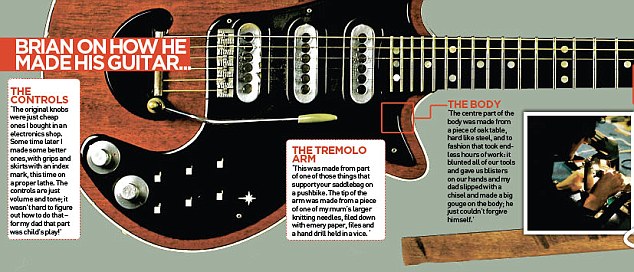
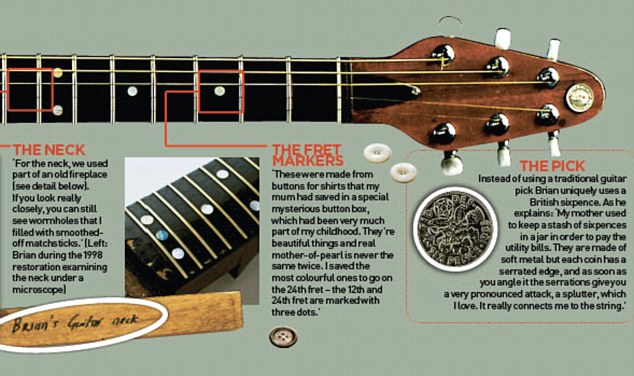
THE FINISH
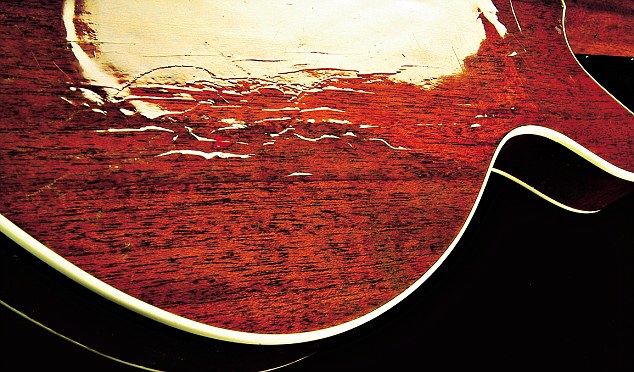
‘I worked with very fine sandpaper, emery paper, glass paper and finally carborundum paste until I eventually got a glassy finish,’ said Brian
‘I wanted it to be a natural-ish enhanced mahogany – reddish brown – it brings out the red a little bit, compared to just varnishing on to bare wood. We used a gentle kind of wood dye and then applied lots and lots of layers of Rustin’s Plastic Coating. I brushed it on and between each successive coat, once dry, I worked with very fine sandpaper, emery paper, glass paper and finally carborundum paste until I eventually got a glassy finish. This was another skill my dad taught me – the tables and bookcases he’s made all had perfect finishes! The Rustin’s finish sustained a lot of wear and tear over the year, but it’s held up surprisingly well.’
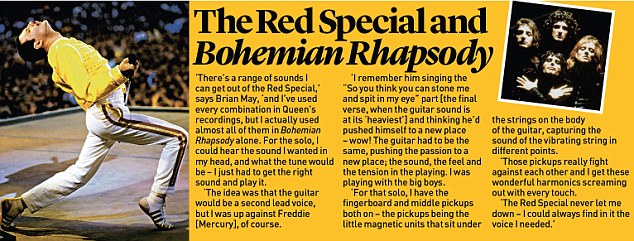
Brian May:
‘There’s a range of sounds I can’t get out of the Red Special,and I’ve used every combination in Queen’s recordings, but I actually used almost all of them in Bohemian Rhapsody alone. For the solo, I could hear the sound I wanted in my head, and what the tune would be – I just had to get the right sound and play it. The idea was that the guitar would be a second lead voice, but I was was up against Freddie [Mercury], of course.
I remember him singing the “So you think you can stone me and spit in my eye” part [the final verse, when the guitar sound is at its ‘heaviest’] and thinking he’d pushed himself to a new place – wow! The guitar had to be the same, pushing the passion to a new place, the sound, the feel and the tension in the playing. I was playing with the big boys.
For that solo, I have the fingerboard and middle pickups both on – the pickups being the little magnetic units that sit under the strings on the body of the guitar, capturing the sound of the vibrating string in different ponts. Those pickups really fight against each other and I get these wonderful harmonics screaming out with every touch.
The Red Special never let me down – I could always find in it the voice I needed.
Abridged extract from ‘Brian May’s Red Special’ by Simon Bradley and Brian May, published on Oct 1 by Carlton, priced £19.99.
Also available: amazon.co.uk
FULL ARTICLE:
